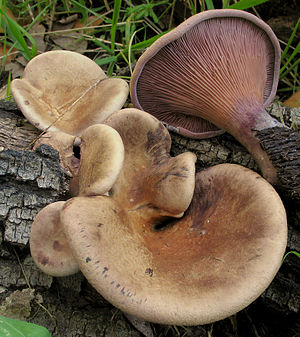Hardwood ball
| Hardwood ball | ||||||||||||
|---|---|---|---|---|---|---|---|---|---|---|---|---|

Hardwood ball ( Panus conchatus ) |
||||||||||||
| Systematics | ||||||||||||
|
||||||||||||
| Scientific name | ||||||||||||
| Panus conchatus | ||||||||||||
| ( Bulliard : Fr. ) Fr. |
The panus conchatus ( Panus conchatus , syn. Lentinus conchatus, L. percomis, L. torulosus and Panus torulosus ), also smooth , birch or variables Knäueling is a fungal art from the family of Stielporlingsverwandten (Polyporaceae).
features
The hardwood ball is a very changeable and multifaceted mushroom. The shell- to fan-shaped fruiting bodies usually grow in tufted clusters, less often individually. The 4–10 cm wide hat is colored lavender to wine red when young and fades ocher with age. The surface is smooth, only older specimens are slightly scaly. The edge of the hat is initially rolled up, later smooth and sharp. The narrow lamellas are tightly packed and run down the short, felty handle. They are white when young, later yellowish to pale, and have a hint of purple. The lamellar edges are entire . The spore powder is creamy white. The central or lateral stalk is short, it can also be absent or it can be fused with stalks of other fruiting bodies. It's full and has a firm, tough consistency. Otherwise, the meat of the hardwood ball is leathery and tough. It smells pleasant, the taste is mild to slightly bitter and astringent.
ecology
The hardwood tangle is a wood-dwelling saprobiont that causes white rot in hardwood stumps, more rarely in lying, thick branches . The preferred substrate is red beech , besides birch and other hardwoods. The fungus rarely colonizes softwood. He has a preference for sub-oceanic, humid, winter-mild locations and rather avoids continental climates with dry summers and cold winters. The species occurs in red beech forests , occasionally in hornbeam-oak forests and hardwood meadows . Outside of forests, it can sometimes be found in hedges or parks.
distribution
The hardwood tangle is widespread, occurrences are known from Australia, Papua New Guinea, Asia (tropical to subarctic regions), North America and Europe (Mediterranean region to Scandinavia). In Germany it occurs scattered, with regional compression and loosening areas.
meaning
The hardwood ball is insignificant as a wood dweller, as an edible mushroom it is not suitable due to its tough consistency and the often bitter taste.
swell
literature
- German Josef Krieglsteiner (Ed.), Andreas Gminder : Die Großpilze Baden-Württemberg . Volume 3: Mushrooms. Leaf mushrooms I. Ulmer, Stuttgart 2001, ISBN 3-8001-3536-1 .
- Hans E. Laux, Andreas Gminder : The great cosmos mushroom guide. All edible mushrooms with their poisonous doppelgangers. Franckh-Kosmos, Stuttgart 2010, ISBN 978-3-440-12408-6 .
- Egon Horak: Bolete and agaric mushrooms in Europe . 6th completely revised edition. Spektrum Akademischer Verlag, Munich 2005, ISBN 3-8274-1478-4 .
Individual evidence
- ↑ Eric Strittmatter: Panus conchatus (Bulliard 1787: Fries 1821) Fries 1838. Mushroom taxa database. Fungiworld.com, archived from the original on January 23, 2013 ; Retrieved March 4, 2012 .

